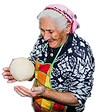
GEITOST
RECIPE
NORWEGIAN GOAT CHEESE from HÅØYA NATURVERKSTED
Captured by The Recipe Hunters
in Norway
The following is an easy do-it-yourself recipe for soft fresh goat's cheese! We travelled all the way to the island of Håøya Naturverksted to document this recipe. Håøya Naturverksted is island farmstead in Oslo, Norway where you can find some of the best goat cheese in Scandinavia. Lise, co-founder and cheese technologist, created this unbelievable recipe with a lot of love! The cheese's lunar interior is mild, soft, and creamy, while the fluffy white rind will leave you with a finishing piquant punch to keep you coming back for more. We recommend that the cheese to be paired with marmalade, nuts, and some crunchy homemade bread. Visit your local dairy farm to get the best raw milk for the recipe. If you can't find raw milk locally, just make sure the milk thatyou buy is not ultra-pasteurized. If the milk that has already been pasteurized, we recommend adding a little calcium chloride to your milk.


Before you begin:
Remember sanitation is key! Making cheese is a hygienically delicate process that requires a high level of sanitation. Anytime you are fermenting food or drink, you have to be ultra cautious of bacterial contamination.
That means:
-
Always wash your hands when dealing with cheese,
-
make sure to wear gloves and wash anything with boiling water or a dishwater that will come into contact with the cheese,
-
and don't touch your face or anything that hasn't been thoroughly cleaned while dealing with the milk and cheese
INGREDIENTS NEEDED
-
Freeze Dried Candidum Culture
-
Rennet
-
Raw Milk (or fresh whole milk NOT ultrapasteurized)
METHOD:
1. Milk the goats

2.
Strain the milk into a large container

Milk
1.
3.
Pasteurize (optional) the goat milk by heating it to 145° F for 30 minutes, then cool it down back to room temperature.

Milk
1.
4.
Add the freeze dried culture to the milk
2 deciliters (dl) for every 13 liters of milk


5.
Add the rennet

1 drop of rennet per liter of milk

6.
Stir the milk, culture, and rennet together.


7.
Cover and store the milk for 12 hours in a cool dark place (61°-64°F or 16-18° C)
8. Remove the free fat floating on the top.

*At this point, the milk should look and have a similar texture to yogurt. What you have now is whey (the liquid) and curd (the congealed mass of milk that looks like yoghurt).

*The molds that you use to shape the cheese should be slightly perforated so that liquid whey can effuse from the cheese.

9.
Using a ladle, gently scoop the milk curd into the individual cheese molds. These molds should have small holes so that the whey can drain from the curd. Fill the molds 80% full.


10. After 30 min carefully flip the cheese onto your hand, then place the cheese back into the cheese mold. * The first flip is the most important and hardest because the cheese will still be very liquidy.

FLIPPING THE CHEESE
Continue to flip the cheese every 10 hours. After the 3rd flip, the cheese will no longer need to be placed back into the mold, since it's shape has been formed and will hold. At this point you will only need to flip the cheese on a drying rack, which has holes for the whey to efuse the cheese. We recommend using a gridded oven rack and placing a sushi mat atop. You can lay the gridded oven rack over your sink.



11.
Two days after the first flip, your cheese, Made with Love, will be ready to share with family and friends! If you prefer a harder and stronger cheese, let the cheese sit out for longer!

FINAL TOUCHES
Add an extra taste to your cheese by decorating it with different flavorful designs! Lise at Håøya Naturverksted adds crushed juniper needles, cuckoo flower and charcoal to her cheese!




LOVE TIPS:
Buy 3-5" perforated gardening pots to use as your individual cheese molds. I found some perfect ones at amazon.com, click on the picture to be brought to the link!
Tip: Buy some sushi rolling mats for straining the whey from the cheese! I found some perfect ones at amazon.com, click on the picture to be brought to the link!
Written by The Recipe Hunters:
Leila Elamine and Anthony Morano





